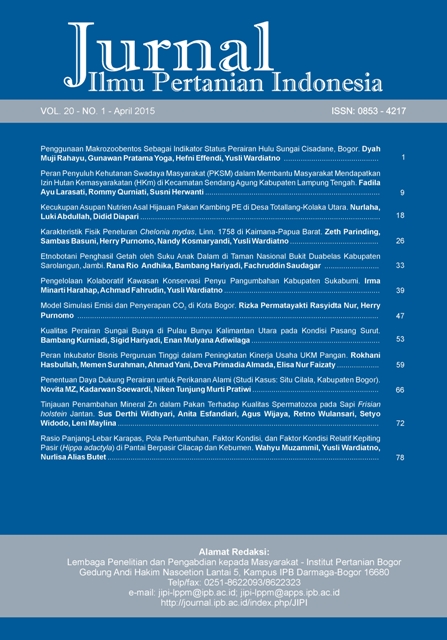Pengelolaan Kolaboratif Kawasan Konservasi Penyu Pangumbahan Kabupaten Sukabumi
Abstract
Establishment of Marine Protected Area Sukabumi once the backup area Pangumbahan as Turtle Beach Coastal Conservation Areas and Small Islands (KKP3K), directly or indirectly, in desperate need of local community participation in the management of the region. Public perception of environmental conservation activities in the region is expected to help better management activities in the marine conservation area. The results of the analysis of the validity and reliability of the indicator variables assessed showed that each variable has a value Corrected Item-Total Correlation greater than 0.300. While the reliability value is greater than 0.700, i.e. 0.827 (perception), 0.897 (participation), 0.894 (law enforcement), 0.858 (policy), and 0.846 for the variable management. Based on the analysis of variables concluded that the perception of stakeholders and local government policies related Pangumbahan Turtle Conservation Area is the most dominant variable in determining the success of the conservation area management.
Downloads
References
Alpı´zar MAQ. 2006. Participation and fisheries management in Costa Rica: from theory to practice. Marine Policy. 30(6): 641-650.
Bennett G, Fry J, González AM, Zilberman S. 2006. Understanding and acceptance of conservation: analyzing perceptions of local communities in the Berau marine protected area, Indonesia-final capstone report. International Development Studies, Elliott School Of International Affairs, George Washington University, Washington DC (US).
Berkes F. 2009. Evolution of co-management: role of knowledge generation, bridging organizations and social learning. Journal of Environmental Management. 90(5): 1692-1702.
Broquere M. 2005. “How many marine protected areas exist in the West Mediterranean?” IUCN Centre for Mediterranean Cooperation. Available at http://www.iucn.org/ places/medoffice/documentos/ Rapport_final_AMP_en.pdf.
Carlsson L, Berkes F. 2005. Co-management: concepts and methodological implications. Journal of Environmental Management. 75(1): 65-76.
Chuenpagdee R, Jentoft S. 2007. Step-zero for fisheries co-management: what precedes implementation. Marine Policy. 31(6): 657-668.
Christie P. 2005. Observed and perceived environ-mental impacts of integrated coastal in two southeast asia sites. Ocean and Coastal Management. 48(3): 252-270.
Cicin-Sain B, Knecht RW. 1998. Integrated Coastal and Ocean Management Concepts and Practices. Island Press, Washington DC (US).
Davis NA. 2008. Evaluating collaborative fisheries management planning: a Canadian case study. Marine Policy. 32(6): 867-876.
Departemen Kelautan dan Perikanan. 2002. Keputusan Menteri Kelautan dan Perikanan Nomor 34 tahun 2002 tentang Pedoman Tata Ruang Pesisir dan Laut.
Evans L, Cherrett N, Pemsl D. 2011. Assessing the impact of fisheries co-management interventions in developing countries: a meta-analysis. Journal of Environmental Management. 92(8): 1938-1949.
Ghozali I, Fuad. 2008. Structural Equation Modeling: Teori, Konsep dan Aplikasi dengan Program Lisrel 8.80. Edisi 2. Badan Penerbit Universitas Diponegoro, Semarang (ID).
Horrill JC. Collaborative Fisheries Management in the Tanga Region. IUCN Tanga Coastal Management Project.
Jentoft S. 2005. Fisheries co-management as empowerment. Marine Policy. 29(1): 1-7.
Kay R, Alder J. 1999. Coastal Planning and Management. E & FN Spon, New York (US).
Mussadun. 2012. Pengelolaan Sumber daya Perikanan Berkelanjutan di Taman Nasional Karimunjawa. [Tesis]. Bogor (ID): Institut Pertanian Bogor.
Nasuchon N, Charles A. 2010. Community involvement in fisheries management: experiences in the Gulf of Thailand countries. Marine Policy. 34(1): 163-169.
Peraturan Pemerintah. 2007. Nomor 60 tentang Konservasi Sumber Daya Ikan.
Pomeroy RS, Parks J, Pollnac R, Campson T, Genio E, Marlessy C, Holle E, Pido M, Nissapa A, Boromthanarat S, Nguyen Thu Hue. 2007. Fish wars: conflict and collaboration in fisheries management in Southeast Asia. Marine Policy. 31(6): 645-656.
Pomeroy RS. 2012. Managing over capacity in small-scale fisheries in South East Asia. Marine Policy. 36(2): 520-527.
Reefbase. 2006. Webpage. Available at: http://www.reefbase.org/management/ man_gaps.
Senko J, Schneller AJ, Solis J, Ollervides F, Nichols WJ. 2011. People helping turtles, turtles helping people: understanding resident attitudes towards sea turtle conservation and opportunities for enhanced community participation in Bahia Magdalena, Mexico. Ocean and Coastal Management. 54(2): 148-157.
Scholz A, Bonzon K, Fujita R, Benjamin N, Woodling N, Black P, Steinback C. 2004. Participatory socioeconomic analysis: drawing on fishermen’s knowledge for marine protected area planning in California. Marine Policy. 28(4): 335-349.
Troeng S, Rankin E. 2005. Long-term conservation efforts contribute to positive green turtle Chelonia mydas nesting trend at Tortuguero, Costa Rica. Biological Conservation. 121(1): 111-116.
Wilson DC, Ahmed M, Siar SV, Kanagaratnam U. 2006. Cross-scale linkages and adaptive management: fisheries co-management in asia. Marine Policy. 30(5): 523-533.
This journal is published under the terms of the Creative Commons Attribution-NonCommercial 4.0 International License. Authors who publish with this journal agree to the following terms: Authors retain copyright and grant the journal right of first publication with the work simultaneously licensed under a Creative Commons Attribution-NonCommercial 4.0 International License. Attribution — You must give appropriate credit, provide a link to the license, and indicate if changes were made. You may do so in any reasonable manner, but not in any way that suggests the licensor endorses you or your use. NonCommercial — You may not use the material for commercial purposes.


















